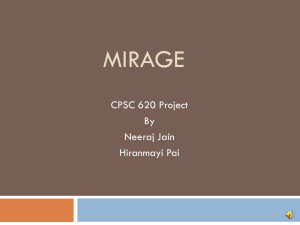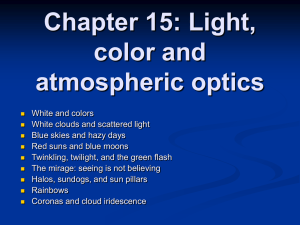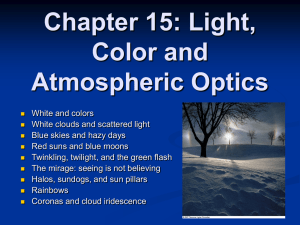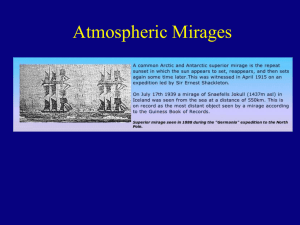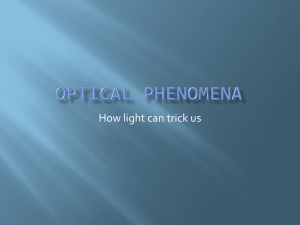Slide 1
advertisement
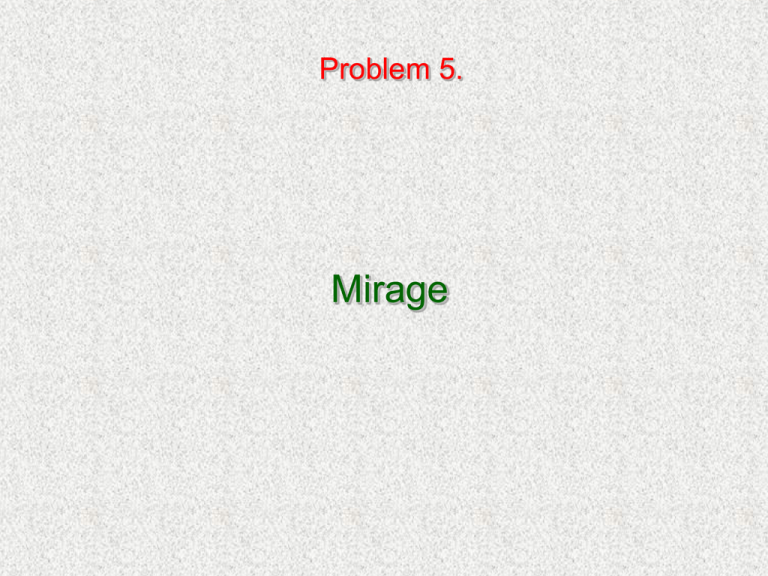
Problem 5. Mirage Mirage Create a mirage like a road or desert mirage in the laboratory and study its parameters. Introduction • What is mirage? • How is it formed? • Which are parameters of a mirage? Experiment Effect: heated surface observed object Formation of mirage n1 sin 1 n2 sin 2 Snell’s law: n1 – index of refraction of first medium n2 – index of refraction of second medium φ1 – ray angle in first medium φ2 – ray angle in second medium n1 φ1 n2 φ2 n1 > n2 → ray is refracting away from vertical Formation of mirage - applying Snell’s law on sequence of parallel planes of infinitesimal thickness whose index of refraction is changing monotonously: n0 sin 0 n1 sin 1 ... n sin y x Formation of mirage In one moment (sooner or later), if sequence of ni isn’t convergent, will be: n0 sin 0 n1 sin 1 ... nn sin n nn1 1 Total reflection occurs and ray is returning. Mirage parameters • index of refraction dependence of temperature • temperature dependence of shift in direction parallel with temperature gradient n1 temperature n2 n3 … nN index of refraction Experiment horizontal line vessel with flourescein termometer Experiment • temperature distribution was measured with thermometer put in the water • rays are photographed and deviation from horizontal line is measured Theoretical model It is sufficient to derive ray equation. • assumptions: • linear dependence of temperature of depth i.e.: dT dy kT • linear dependence of index of refraction of temperature i.e.: dn kn dT Theoretical model We will use following coordinate system and following equations: x φ y -dy dx dx tan dy Snell’s law in differential form: n sin( ) (n dn) sin( d ) ……. Theoretical model Ray equation: 1 y y0 p re 2 n0 sin 0 p kT kn 1 q sin 0 r q q 1 2 dT kT dy dn kn dT x p 1 e q r x p y0 – initial depth n0 – initial index of refraction φ0 – initial ray angle Results Temperature gradient 01 370 360 Temperature [K] 350 340 330 320 310 300 290 0 5 10 15 depth [cm] 20 25 30 Results Mirage gradient 02 Mirage gradient 03 340 340 330 Temperature [K] Temperature [K] 330 320 310 300 310 300 290 0 5 10 15 20 25 30 depth [cm] 290 0 5 10 15 20 25 depth [cm] Mirage gradient 04 kT1=-0.78Kmm-1 330 325 kT3=-0.40Kmm-1 320 Temperature [K] 320 315 kT2=-0.32Kmm-1 310 305 kT4=-0.27Kmm-1 300 295 0 5 10 15 depth [cm] 20 25 30 30 Results Mirage gradient 370 360 gradient 1 Temperatura [K] 350 gradient 3 340 gradient 2 330 gradient 4 320 310 300 290 0 5 10 15 dubina [cm] 20 25 30 Results 24 measurements ray equation fit 22 depth [mm] 20 18 16 14 12 0 100 200 deviation [mm] 300 400 500 Results Mirage 3 26 32 24 30 22 28 depth [mm] depth [mm] Mirage 2 20 18 26 24 16 22 14 20 12 18 0 20 40 60 deviation [cm] 0 200 400 deviation [mm] Mirage 4 kn1=-4.86*10-4K-1 32 30 kn3=-4.58*10-4K-1 depth [mm] 28 26 kn2=-4.68*10-4K-1 24 22 20 kn4=-4.75*10-4K-1 18 16 0 10 20 30 deviation [cm] 40 50 60 600 Results For coefficient of dependence of index of refraction of water on temperature we got (in interval ≈ 318K – 358K): dn 4 1 k n (4.72 0.06) 10 K dT According to literature: dn 4 1 4.5 10 K dT Conclusion • we created mirage in a laboratory • we constructed theoretical model whose results are good compared to literature • mirage parameters are dependence of temperature on depth and dependence of index of refraction on temperature • for water: dn 4 1 (4.72 0.06) 10 K dT • for practical reasons we photographed and measured ray in water but we have also created mirage in air
